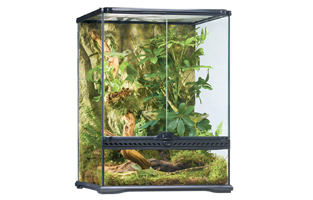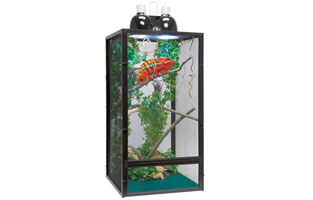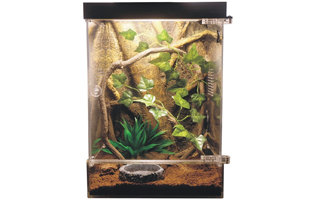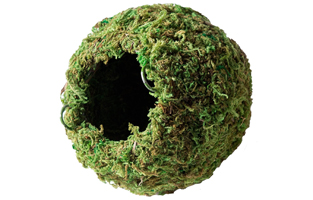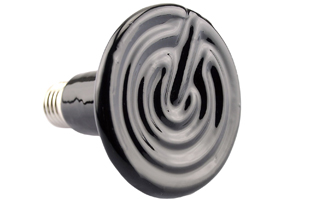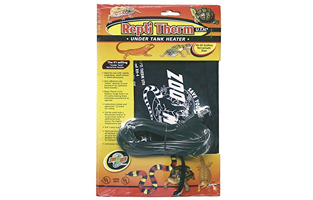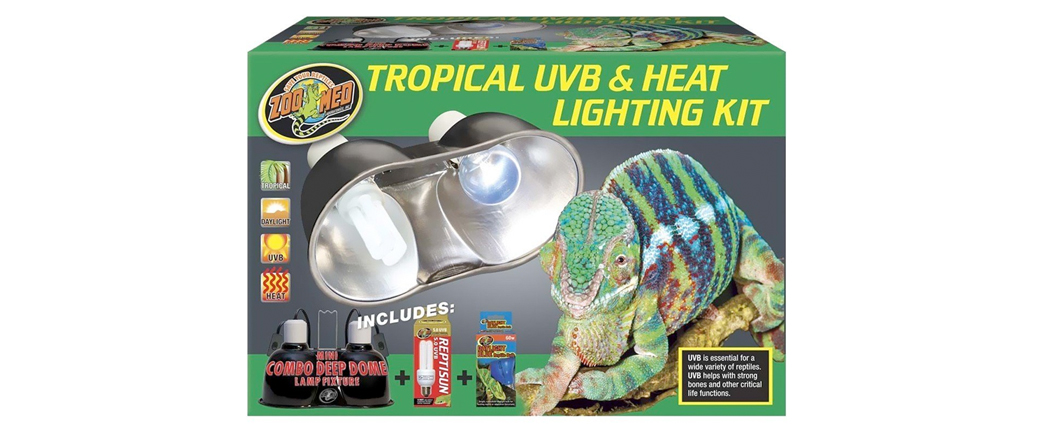How To Build A Chameleon Vivarium

Every successful chameleon vivarium must feature:
- An enclosure that is large enough in size for the type and number of chameleons housed inside.
- Miniature trees or branches on which for the chameleon to dwell.
- Sufficient humidity to keep your chameleon happy.
- Water (which must be in an accessible location for your pet chameleon)
- Gradients that allow the chameleon to regulate its temperature by moving to different areas of the terrarium.
- Lighting that not only heats the chameleon vivarium, but also simulates the day and night cycle.
- Healthy food – appropriate for your type of chameleon.
- Proper disinfecting of the enclosure and all furnishings within.
- Diligent monitoring of your chameleon and its vivarium.
- Access to an experienced veterinarian should trouble arise.
For more information on how to build a chameleon vivarium and care for your new pet chameleon, we suggest you read one of the following five chameleon pet care manuals. These books will teach you everything you need to know about owning a chameleon and building a vivarium that will keep your pet chameleon happy and healthy.
What Is A Chameleon?
Chameleons are a distinctive type of lizard with anywhere from 150 – 202 known species. These species come in a range of sizes and colors – with many of these chameleon species being able to change their skin color, depending on the animal’s mood and surroundings.
Chameleons are distinguished by their zygodactylous feet; their long, rapidly extendable tongues; their swaying gait; and crests or horns on their distinctively shaped heads. Most species, the larger ones in particular, also have a prehensile tail. Chameleons’ eyes are independently mobile, but in aiming at a prey item, they focus forward in coordination, affording the animal incredible vision. Chameleons are adapted for climbing and visual hunting. They are found in warm habitats that range from rainforest to desert conditions with various species being found naturally in Africa, Madagascar, southern Europe, and across southern Asia. They also have been introduced to the US states of California, Florida, and Hawaii.
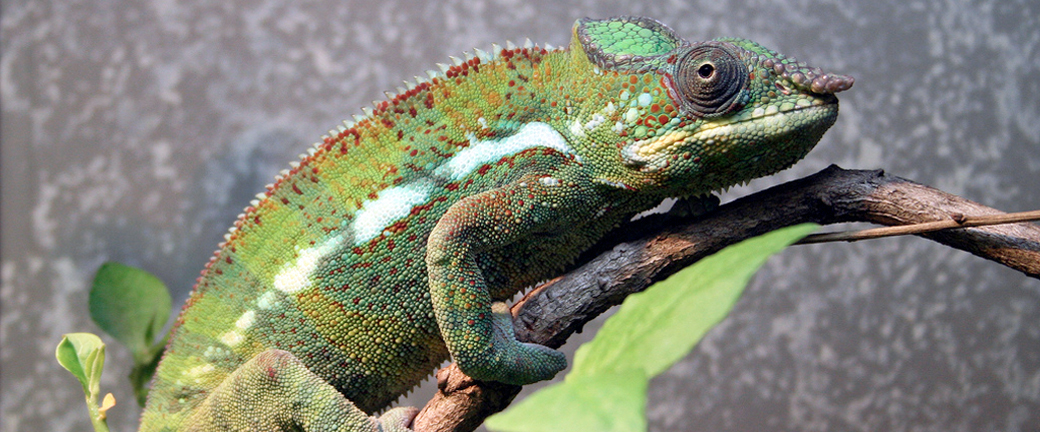
Common Chameleon Breeds
There are several hundred types of chameleons. However, there are really only a handful of chameleons that are commonly kept as pets. This list will give you a basic understanding of these various chameleon types.
This breed of chameleon posses a very distinct difference between males and females of its species, making it very easy to identify its gender. Males are much larger and have a distinguishable orn that extends from their forehead. Females are much smaller, but contract to popular belief, they also have horns. However, a female’s horn is only about an eighth of the size of males. Fischer chameleons are tough and thrive in high temperatures and humidity.
High Casqued chameleons can be found in a variety of different colors. it often displays a dark color when basking since these darker colors offer optimum light absorption. Like most breeds, makes are noticeably larger than females. Males have a single horn extending from their forehead, a serrated back, and tiny spikes that run along their neck. Females do not share any of these features. Males will express their desire to mate by sporting brilliant colors in an effort to compete with other male chameleons. One of the most incredible features of a High Casqued chameleon is that it can extend its tongue to the same length as its body!
The Jackson’s chameleon only grows to around 12 inches and has a varying lifespan. it will reach its sexual maturity at around the five month point. Although most Jackson’s chameleons are bright green, there are instances where blue and even yellow lizards of this breed have been documented. As with all chameleons, they change color depending on their mood.
One of the largest chameleons in existence in the Meller’s chameleon. It can reach 24 inches in length! Females are distinguished by their small dorsal crests. Depending on its mood, the Meller’s chameleon can be found in brown, black, yellow or dark green colors. This breed is quite popular in the pet industry due to its long lifespan of approximately 12 years – depending, of course, on how well the animal is kept.
Namaqua chameleons are tough little animals and can survive in extremely harsh environments like this found in the desert. They tend to vary in color depending on the time of day – often changing colors from day to night time. They are one of the quickest types of chameleons – using their speed to catch prey and evade being the prey for larger, desert-dwelling animals. Namaqua chameleons get much of their speed from the fact that they can spread their toes wide apart.
This chameleon is characterized by vibrant colors so it’s often considered one of the most aesthetically pleasing chameleon breeds. In fact, some people have even considered it to be the most eye-catching lizard in the entire animal kingdom. Make Panther chameleons can be around 20 inches in size, while female Panther chameleons are a bit smaller. In addition to its size, male Panther Chameleons are identified by their vivid color in comparison to the females of their species. Females will also lose their color when laying eggs – to show makes that she is not interesting in mating. Panther chameleons live for an average of 10 years, but females will only live for two to three years after laying their eggs.
The Parson’s chameleon is the second largest breed of chameleon and makes can reach up to 27 inches in length, while females tend to measure in at around 19 inches long. Parson’s chameleons love running water, live up to seven years, and a female can lay 50 eggs every two years.
Pygmy chameleons are small, only reaching three inches in length. Unlike most chameleons, Pygmy chameleons do change color to match their environment. When they are not hiding, Pygmy chameleons will transform into a darker color, resembling a dry leaf. They do this in order to blend in with their environment while sleeping. Pygmy chameleons will also change colors based on their emotions – including green, orange, brown and black. Finally, the Pygmy’s tongue is longer than its body, making it excellent at hunting small insects, of which it feeds.
Veiled chameleons are among the most popular chameleon pets. They can changed color depending on their surroundings and mood. Its natural color is a shade of gren, but it can easily turn lime green or red in certain environments. Males are distinguished by their spurs running along their legs. Male Veiled chameleons can reach a length of 24 inches while females are only about half that size. During mating, the males will exhibit compelling colors in order to attract the opposite sex.

What Type Of Chameleon Cage Is Best?
Chameleons are among the most solitary and territorial of lizards. Some chameleons insist on living lives punctuated only by occasional visits with the opposite sex for the sole purpose of breeding. Other species seem to exist in the wild in pairs. Still others might be found in loose groupings consisting of a single male and two or more females. No chameleon species could be considered communal and living in large groups – or groups of any kind.
In captivity, it is usually impossible to keep more than a single sexually mature male of any given chameleon species in a single cage. Intra-specific aggression among males can be persistent and fatal, so it is important that you keep your chameleons in separate vivariums in almost all instances. In some instances, it is important that no two chameleons even see one another – even if separated by a separate cage. Chameleons are incredibly territorial and can becomes stressed to the point of death if they feel they are even close to another chameleon.
That being said, if it’s not crowded, you may usually keep anywhere from one to seven adult female chameleons with each male. Although the females are usually somewhat less aggressive towards each other, hierarchies have been known to occur, so it is important that you keep a close eye on your chameleons and remove and problem animals from your vivarium at the earliest sign of territory battles. To do this, you should take note of any changes in feeding or drinking patterns.
There are three different chameleon vivariums that we recommend for beginners. These vivariums will comfotably house small to medium-sized chameleons, but if you have an extremely large chameleon, then you made want to consider a slightly larger vivarium.
![]() The number of chameleons you have will also work to determine how big your vivarium should be. While it is also possible to keep two diverse species of chameleons in the same vivarium together. When this is done, the chameleons with either battle with one another or pay not attention to the other species. Obviously, you want to create a situation that is more suited toward the later – where all the chameleons in your vivarium are able to feed, drink and relax without being overly stressed or stimulated by the other animals in their cage.
The number of chameleons you have will also work to determine how big your vivarium should be. While it is also possible to keep two diverse species of chameleons in the same vivarium together. When this is done, the chameleons with either battle with one another or pay not attention to the other species. Obviously, you want to create a situation that is more suited toward the later – where all the chameleons in your vivarium are able to feed, drink and relax without being overly stressed or stimulated by the other animals in their cage.
A glass or plastic top will help retain the high humidity preferred by many of the denizens of these habitats. If the humidity remains too high it can be reduced by sustaining a screen, or a combination screen and glass cover for the full glass one.
Chameleon Terrarium Flooring
When constructing a woodland terrarium suitable for a chameleon of any side, I suggest first placing an inch or two of pea-sized gravel as the base of the substrate. On top of this I lay a thickness or two of air-conditioning filter material cut to the exact size of the terrarium. This latter prevents the two or three inches of soil that comes next from filling in the spaces between the gravel. The rocks below the filter material act as a reservoir that will prevent excess water from destroying the roots of your plants if you should happen to over-water.
Some chameleon terrariums keepers prefer a simplified approach. With this, several inches of commercially available wood mulch (cypress, aspen, etc – but not cedar) is used as the substrate and the plants that are used remain in their pots, merely being sunk to the pot rim in the mulch. This is an easily cleaned arrangement. The mulch can be washed, sterilized, dried and reused.
Chameleon Cage Furnishings
Cage furnishings for chameleons can be both functional and decorative. Among the primarily functional examples are such items as the “heating limbs.” Some of the more terrestrial chameleons seem to enjoy clambering about on rock formations, prone limbs, etc. Sturdy vine plants and elevated limbs will provide both perches and visual barriers as well as adding beauty to the terrarium. Attractive pieces of dried (sometimes bleached or sandblasted) manzanita, grape, or other gnarled woods, are often available at pet shops or from the wild.
![]() If multi-layered rock formations are provided, the rocks should be held in place with a non-toxic adhesive. Latex aquarium sealant is quite satisfactory for this purpose. If even a single flat rock is placed on the surface of the sand it should be ascertained that it can not accidentally shift and injure your chameleon. Natural rocks provide better claw holds for your specimens than the decorative glass rocks do. If misted, rocks, limbs, and vegetarian can all provide drinking stations for your pet chameleon.
If multi-layered rock formations are provided, the rocks should be held in place with a non-toxic adhesive. Latex aquarium sealant is quite satisfactory for this purpose. If even a single flat rock is placed on the surface of the sand it should be ascertained that it can not accidentally shift and injure your chameleon. Natural rocks provide better claw holds for your specimens than the decorative glass rocks do. If misted, rocks, limbs, and vegetarian can all provide drinking stations for your pet chameleon.
Lighting & Heating For A Chameleon Vivarium
Chameleons require exactly 12 hours of light per day. This allows them to properly produce a vitamin that is crucial to properly absorb calcium (Vitamin D3). This light needs to be as close to the chameleon as possible without actually coming into contact with him or any other items within the terrarium.
The temperatures at which chameleons are comfortable – and the temperatures you will need to offer in your caging – vary according to the species of chameleon that you choose to keep. Desert and dry savanna species, such as the veiled or the North American subspecies of the common chameleon, prefer warmer temperatures, but lower humidity. The desert chameleons are even able to withstand temperatures as high as 95 degrees Fahrenheit (or 35 degrees Celsius) with no ill effects. Whereas high-altitude species would be quickly and noticeably be distressed by such warm temperatures and climates. No matter what type of chameleon you have, nighttime temperatures can and, most likely, should be somewhat cooler than daytime temperatures.
A chameleon cage that is maintained in the low seventies Fahrenheit (21 – 23 Celsius) by day and in the low sixties Fahrenheit (16 – 18 Celsius) will prove ideal for the vast majority of chameleon species. Be sure, however, to provide a warmed basking area within your chameleon vivarium where there is a surface temperature of 88 degrees Fahrenheit (31 C) during the hours of daylight by the prudent use of a floodlight or overhead heat lamp. Except in the case of the few terrestrial chameleon species that will bask on the ground, the warmed basking area should be a suitably sized, elevated branch or limb.
![]() To light and heat your chameleon terrarium, place the light over a branch so that the chameleon will be tempted to bask in its light. It should be placed at a slight angle, so that the sun doesn’t come straight down on the vivarium at a ninety degree angle – thereby simulating the way the sun should shine on a chameleon in the wild.
To light and heat your chameleon terrarium, place the light over a branch so that the chameleon will be tempted to bask in its light. It should be placed at a slight angle, so that the sun doesn’t come straight down on the vivarium at a ninety degree angle – thereby simulating the way the sun should shine on a chameleon in the wild.
Terrarium lights can be used not only for their primary purpose of illuminating a cage, but also as a reliable and easily controlled heat source. Inexpensive in-line thermostats or rheostats can be installed by electricians. Plug-in timers are also readily available at hardware stores or online.
Heating pads, heat tapes, and understand heaters are easily procured online or in pet stores. By placing one of these heat devices at one of the terrarium you can create a desired thermal gradient.
Ceramic heaters that screw into incandescent sockets are also readily available. Providing warmth from above, they heat the interior of the terrarium but emit no light. If these are used, it will be necessary to also use terrarium lighting during daylight hours.
Unfiltered sunlight is unquestionably the best provider of UV light for your pet chameleon. If filtered through regular glass or plexiglass, a great deal of the UV is removed from natural sunlight. However, glass and plexiglass terrariums should not be used if you plan to place your chameleon in direct sunlight, as the glass in these types of terrariums can super-heat your vivarium to the point where your chameleon becomes either sick or dies from the excess temperatures. This is why wire-covered wood-frame cages are best suited to take advantage of natural sunlight in outdoor locations.
Two wavelengths of UV light are produced by full-spectrum bulbs. These are UV-A and UV-B. UV-A has been shown, time and time again, to promote natural behaviors in reptiles. The findings are equally favorable for UV-B. This latter type of lighting common in chameleon vivarium setups helps to stimulate the synthesis of vitamin D3 – the presence of which enhances calcium absorption and metabolization. While there are new full-spectrum flourescant bulbs that have recently been developed, these types of bulbs are really only meant to be used as a source of lighting and will provide your chameleon with little to none of the UV light it needs.
While most wild chameleons rarely avail themselves to the benefits of UV-producing sunlight, even forest-floor dwelling chameleons derive benefits from the UV rays that are emitted by the sun. Because chameleons get UV light in the wild, it’s also a good idea to ensure that your pet chameleon also has a healthy source of UV in the terrarium where he or she is kept.
For a chameleon to benefit from artificial UV lighting, the fluorescent bulbs used in reptile-friendly UV lights must be kept approximately 12 – 18 inches away from the chameleon you are keeping. Therefore, a basking perch (on a branch or tree limb), must be located about this distance away from the light source.
It’s extremely important that your chameleon has a basking area on one side of it’s terrarium that is between 90 and 105 degrees Fahrenheit, while ensuring that the rest of the vivarium is cooler. In fact, the whole chameleon vivarium should be around 70 degrees at night and 80 degrees Fahrenheirt during the day. Some type of chameleons will develop respiratory issues if they are not giving enough space to bask or are not provided with the correct areas in which to bask during the daylight house.

Best Place To Keep A Chameleon Vivarium
You can place your chameleon vivarium near a window so long as you pay attention to your chameleon’s reaction to it’s position in this location. if it keeps trying to escape from the cage or stops eating or drinking, you should relocate the terrarium immediately.
While it is good for your chameleon to get natural sunlight, leaving your chameleon near a window can actually kill your pet – especially if you are keeping your chameleon in a glass aquarium. The sun will shine through the window and cause a greenhouse effect inside the terrarium – thereby heating up your vivarium to the point that it kills any chameleons inside. So, if you place your chameleon vivarium near a window, then you should have shares that are closed during the daylight hours.
If you can, place your chameleon terrarium on a desk or table so that it’s off the ground. Chameleons like to dwell in the treetops and they love to be high off of the ground. So, if you can simulate that type of environment with the location of your vivarium, that will be ideal. Just be sure not to place your terrarium so high that you can not easily access it.
Another thing to keep in mind when placing a glass chameleon terrarium in a room of any kind if that if a chameleon sees a reflection of itself, it may mistake it for another chameleon encroaching on its territory – causing it to becomes stressed. If reflection is causing a problem in your vivarium, simply buy a vivarium background and place it within your chameleon terrarium – thereby blocking out the reflection in the glass.
Finally, beware of other pets you might have in the same room as your chameleon. Cats love to stalk animals like chameleons and may be tempted to jump on your vivarium or pry off the lid of a chameleon terrarium to access the animal within – thereby causing stress and possibly even death to your pet chameleons. If you do have a ca or any other such pet, you should keep your chameleon in a separate room and keep the door closed at all times. You should also buy a metal top for your chameleon vivarium so that your cat doesn’t accidentally fall through it or pry it from its housing.
Cleaning Your Chameleon Terrarium
Terrarium cleanliness is one of the most important aspects of successful chameleon husbandry. The substrate flooring should be changed or washed frequently, the perches should be scraped and washed as necessary (or discarded), and all hard surfaces, such as rocks and glass, should be cleaned or sterilized on a regular schedule. Water, whether in bowls, or in daily mistings, must be clean and fresh.
Fortunately, chameleons are not messy animals and are relatively easy to care for. Keeping a chameleon vivarium clean is usually rather easy. To sterilize perches, twigs, rocks, cork bark, and the terrarium itself, a diluted solution of either Ro-Cal or chlorine bleach should be used. After cleaning and sterilizing the items, be sure all are thoroughly rinsed with clean, fresh water.
Do not use pine oils or other phenol-based disinfectants for cleaning your chameleon cage. Phenols are absorbed through the skin and can cause illness or kill your pet chameleon. Even lingering odors can be deadly!
Your chameleon terrarium’s cleanliness will do much to ensure the long-term health of your new pet chameleon. Regular cleaning will help prevent the spread of both diseases and parasites. The cleaning of terraria should be a prominent part of your chameleon care regimen.

Fun Facts About Chameleons
- Chameleons can see in color – which is something that most reptiles can not do.
- Chameleons are climbing animals. Their hands and feet are built perfectly for gripping branches. They do not like surfaces with no traction – such as glass and slick plastics.
- Chameleons like to sleep upside down or in a corner – so if you notice your chameleon doing this – don’t worry. Your chameleon isn’t sick or dead. This is perfectly normal behavior for a chameleon.
- Chameleons are extremely territorial animals and are not a sociable pet. They have been known to be threatened even by their own reflection.
- Chameleons shed their skin as they grow. However, they do not shed all of their skin at once. Chameleons can shed their skin in patches and this process can take weeks to complete.
- A chameleon will puff up when it is ready to shed its skin. You’ll notice your chameleon rubbing against rocks, twisting about, and even trying to use its feet to pull off the dead skin during the shedding process.
- Don’t help your chameleon pick or pull at its dead skin during the shedding process. Your chameleon’s skill will fall off naturally. You might actually injure your chameleon if you try and help it to pull of its dead and shedding skin.
- A chameleon’s shedding cycle is a great way to determine its health, so it is a good idea to keep a journal of when it sheds – making sure to write down the date of the sheddings and any significant events that might occur during this time in your pet chameleon’s life.
- If you discover that your chameleon is sleeping during the daylight hours, this is a surefire way to know that your chameleon is sick and in need of treatment. Chameleons do not normally sleep during the day!
Photos by: Yosser, Earth-Bound Misfit, I, anibus333, paulschaffner, Bhavik thaker, D. Richard Hipp, nomis-simon, kittenfc, midnightcomm, Shehan Obeysekera, rooneg and paulshaffner.





